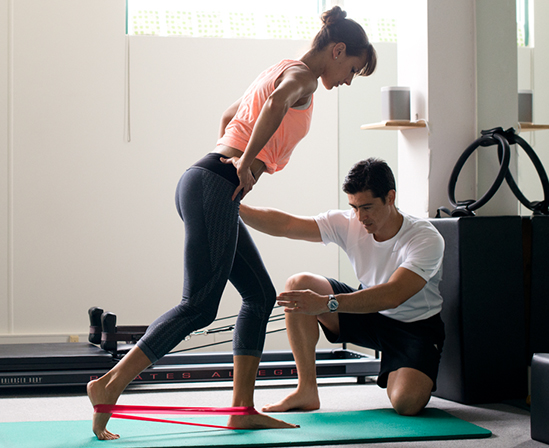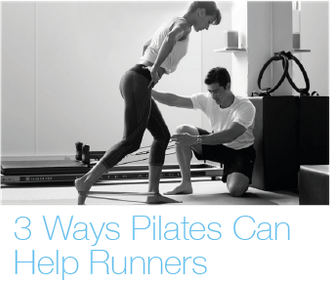3 reasons Pilates should be part of a Runner’s programme:
3 reasons Pilates should be part of a Runner’s programme. By John Contreras Physiotherapist, Pilates Instructor (APPI Master Trainer), Certified Strength & Conditioning Specialist (NCSA) Despite there being good evidence in the research for the use of exercise to rehabilitate the majority of injuries seen in runners, there is still a lack of good evidence for any one approach to help with injury prevention. Nonetheless, I feel that there are 3 main reasons Runners should integrate Pilates into their programme.
- Running is a skill and therefore requires awareness.
Despite what various sporting apparel companies tell us, running isn’t an activity we can all do well. Even though I am a huge advocate of my patients participating in many forms of exercise, running is a complex neuro-muscular skill that requires practice and graduated progression. In fact, one area of running injury research that is becoming more prevalent, is the use of running re-training in the management of injured patients. Currently the evidence suggests that running re-training may be beneficial in the management of runners with a number of lower limb conditionings (Barton et al., 2016). In my opinion, one of the main benefits of Pilates is an acute improvement in body awareness. By teaching movements with a range of tactile and verbal cues and visual imagery, Pilates may improve the ability of our patients to better incorporate the running retraining principles advocated. Interestingly, a recent study observed that female runners with patellofemoral pain had improved running mechanics and reduced pain after 8 session of treadmill running training that incorporated visual feedback using a mirror and verbal cues (Willy, Scholz, & Davis, 2012).
- As running speed increases, so does the demand on the proximal musculature of the hip.
Various studies have demonstrated that as a runner’s speed increases, the demand on the hip musculature does as well. One of the many reasons for this is that as you move faster, contact time on the ground reduces towards a point where the calf works as a stiff spring. So apart from needing robust muscle-tendon systems in the foot and ankle, greater work is needed to swing the hip and knee quicker and increase stride frequency (Dorn, Schache, & Pandy, 2012),turning you from a jogger into Usain Bolt! Pilates exercises that target iliopsoas, gluteals and hamstrings in an isolated fashion can be a great way to start building capacity prior to incorporating higher speed/intensity movements.
- Reducing Risk factors for running injuries.
I am regularly seen by patients who ask whether Pilates will reduce their risk of injury. I always find this an interesting question to answer, as it provides me with a great opportunity to educate them on what the role of Pilates may be in their conditioning. I feel there are two main issues to consider here. Firstly, I would argue that the most effective way to reduce running injuries is by appropriately managing training load ( doubling your weekly volume from 10 to 30km isn’t such a good idea...). Secondly, I would say that Pilates may play a role with reducing some of the risk factors observed to be associated with running injuries. Possible risk factors such as lower limb weakness and flexibility (Fields, Sykes, Walker, & Jackson, 2010) may be addressed with Pilates. So, although I don’t think Pilates can address all potential risk factors (I don’t think any one approach can), I feel that Pilates is fantastic method to address these potential contributing factors using a range of Matwork and/or Equipment Pilates movements.
APPI Pilates for Runners
Join John on the APPI Pilates for Runners course this year in Australia. Over the duration of this one day course you will explore the use of matwork & small equipment (theraband, magic circle, swiss ball and foam roller) Pilates exercises as well as some reformer based exercises that improve the skill, strength and performance of your running client. The course will examine the biomechanical and physiological requirements for successful running and suitable Pilates exercises aimed at improving running performance. Read more about the APPI Pilates for Runners course here. Melbourne 3 September MORE INFO / BOOK NOW  References Barton, C., Bonanno, D., Carr, J., Neal, B., Malliaras, P., Franklyn-Miller, A., & Menz, H. (2016). Running retraining to treat lower limb injuries: a mixed-methods study of current evidence synthesised with expert opinion. British Journal of Sports Medicine, bjsports-2015-095278. Dorn, T. W., Schache, A. G., & Pandy, M. G. (2012). Muscular strategy shift in human running: dependence of running speed on hip and ankle muscle performance. The Journal of experimental biology, 215(11), 1944-1956. Fields, K. B., Sykes, J. C., Walker, K. M., & Jackson, J. C. (2010). Prevention of running injuries. Curr Sports Med Rep, 9(3), 176-182. Willy, R. W., Scholz, J. P., & Davis, I. S. (2012). Mirror gait retraining for the treatment of patellofemoral pain in female runners. Clinical Biomechanics, 27(10), 1045-1051.
References Barton, C., Bonanno, D., Carr, J., Neal, B., Malliaras, P., Franklyn-Miller, A., & Menz, H. (2016). Running retraining to treat lower limb injuries: a mixed-methods study of current evidence synthesised with expert opinion. British Journal of Sports Medicine, bjsports-2015-095278. Dorn, T. W., Schache, A. G., & Pandy, M. G. (2012). Muscular strategy shift in human running: dependence of running speed on hip and ankle muscle performance. The Journal of experimental biology, 215(11), 1944-1956. Fields, K. B., Sykes, J. C., Walker, K. M., & Jackson, J. C. (2010). Prevention of running injuries. Curr Sports Med Rep, 9(3), 176-182. Willy, R. W., Scholz, J. P., & Davis, I. S. (2012). Mirror gait retraining for the treatment of patellofemoral pain in female runners. Clinical Biomechanics, 27(10), 1045-1051.
